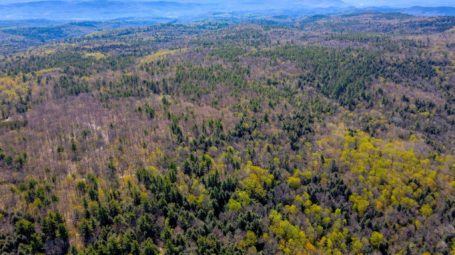Slowing the flow at Crooked Creek
5 min read / April 17, 2024
Our website uses cookies to improve your experience. To learn more about how we use cookies, please review our privacy policy.
Can't find what you're looking for? Please contact us.
About 70 years ago, a dairy farmer in Colchester dammed a small stream to create an irrigation pond. Over time this unnatural obstruction changed the creek’s natural flow, affecting stream health, water quality, and wildlife habitat.
The stream, Crooked Creek, flows for about a mile before meeting Lake Champlain.
The farm is now VLT-conserved land that Gene Button’s family has stewarded since the late 1800s. Led by staff ecologist Allaire Diamond, we have been implementing innovative projects here to restore the stream and surrounding land.
The earthen dam was built in the early 1950s with an outlet pipe directing water downstream. The steep-sided, flat-bottomed valley below the dam was a virtually treeless pasture. As cows roamed they compacted the soil. Crooked Creek became narrow and grew deeper each year as water pouring from the outlet pipe cut deeply into, or incised, the valley bottom even more.
Confined in this ever-deepening channel, the creek could no longer reach its floodplain. That is the low-lying area beyond stream banks where water would naturally spread after storms or snowmelt.
Instead, like a pipe being flushed, water rushed out of the valley. It carried soil particles and nutrients like phosphorus to Lake Champlain. This forceful movement also degraded habitat for fish, bugs, and other animals.
When livestock stopped using the valley in the 1960s, the forest began to return with fast-growing trees like white pine. Today, slower-growing oaks and maples branch beneath the now-towering pines. But the valley’s return to a highly functional ecosystem will take decades, even centuries.
Together with Gene and a team of private, nonprofit, and agency partners, we developed a multiyear plan: remove the earthen dam, and restore stream and wetland features in the Crooked Creek area.
“Our hope with this restoration project is to expedite that natural regeneration timeline,” says Allaire, “so the stream system can be healthier and the water reaching Lake Champlain cleaner.”
(Photo: Engineer Rodrigue Spinette of Fitzgerald Environmental Associates and VLT ecologist Allaire Diamond review engineering plan on site at Button Farm, Colchester.)
Our first project aimed to restore the stream downstream of the dam, partly so that it could function better after the dam was removed. We designed wood structures modeled on beaver dams and natural logjams.
A team of UVM students helped build and install about 25 ‘beaver dam analogs’—pounding in vertical stakes of nonnative buckthorn wood, then weaving flexible willow stems between them.
We also added piles of logs and posts along the creek sides. These logjams help create a meandering pattern by forcing water to flow in a sinuous pattern.
We saw results quickly! When heavy rains swelled the creek later that fall, the water slowed, pooled behind these new structures, and swelled into the floodplain. That was a clear sign that these woody additions can slow floodwaters. They also help trap sediment, raise the local water table, and increase wetland area.
“Eventually, we hope that these structures help create a wetter valley, where plants like alder and willow will take root and provide food for beavers, who can sustain this complex and dynamic ecosystem better than any human volunteer,” adds Allaire.
Next, we focused our restoration efforts on removing the earthen dam and restoring wetland in its shadow, a priority identified several years before in a regional clean water plan. An innovative design developed by hydrology experts and engineers aimed to create a ‘Stage Zero’ stream valley, where the water spreads across a broad area full of natural wood, like a long-undisturbed wetland.
In the summer of 2022, contractors breached the dam to drain the pond, then moved the accumulated sediment to create a broad valley with connected depressions. They also embedded tree trunks in the valley bottom to function as natural weirs.
After September rains, the logs were successfully helping the stream spread out, as intended. And cattails popped right back up after our work was done!
The dam removal and valley restoration achieved a valley bottom about 25 to 35 feet wide, with logs, native plants, and rocks adding structure. Crooked Creek is usually just four to six feet wide, but creating a wide space means the water won’t be forced into the same spot repeatedly. Instead, it can take different paths and move throughout the valley.
“Streams naturally move and change over time,” explains Allaire. “A healthy stream can have many strands that can braid or join, separate, and then come back together. It’s not very deep, rising water spreads into the surrounding land, and wetlands are part of the system. It’s very diverse in terms of wildlife, plants, and other species.”
Healthy watersheds are better able to handle intense storms that are now more common. Through projects like these, we’re learning how to make Vermont’s watersheds more resilient, one stream at a time.
We are working on this project with collaborators at The Nature Conservancy, the University of Vermont, Vermont Youth Conservation Corps, and private consultants from Riverscape Ecology and Fitzgerald Environmental Associates on this project, with funding support from the National Fish and Wildlife Foundation’s Northeast Streams and Rivers Fund, Vermont Department of Environmental Conservation’s Dam Removal Grant, VLT donors, and others.
Watch a recording of Leila’s Vermont talk in April 2024 about beavers and the crucial role they play in the health of our rivers, watersheds, and forests.
Watch video










We generally send two emails per month. You can unsubscribe at any time.